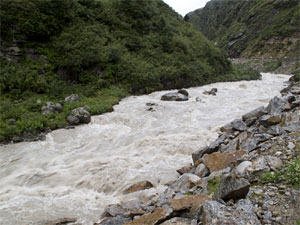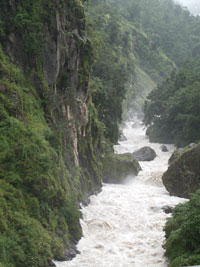In Nepali, Bhote Kosi means 'River from Tibet' (Bhot = Tibet, and Kosi or Koshi = river). In Tibet the river is called Rongshar Tsangpo or Shishapangma Chu.
The Bhote Kosi has its main watershed in the foothills of Mount Shishapangma (although another tributary comes together at Nyalam). The river thunders down from Tibet into Nepal, flowing under the Friendship Bridge that forms the border crossing between Tibet and Nepal. The river is narrow, but spectacular for its staggering drop of several thousand metres on its course from Tibet to Nepal, cascading through tremendous gorges with waterfalls and rapids. In fact, it is the steepest river rafted in Nepal.
With a gradient of 15m per km, the Bhote Kosi is eight times as steep as the Sun Kosi (Matsang Tsangpo), which it feeds further downstream. The Bhote Kosi carves a steep and direct drop at the Nepal border that gradually eases to more placid streams and calmer pools with a 46-km run at Lamosunga Dam in Nepal. The rapids here are Class IV to V at high flow, and Class III at lower levels. The Belephi Khola comes in below the hard whitewater section, and below this junction it is called the Upper Sun Kosi. The Upper Sun Kosi joins the Indrawati at Dologhat and becomes the main Sun Kosi.
The Sun Kosi then joins forces with the Arun (Tibetan name: Bhumchu), which is sourced near Mt. Everest on the north side. Technically, the Arun flows into the Sun Kosi (as the Arun has a smaller volume of water). Between Dolaghat and the Arun there are also two other major tributaries. The first one is the Tamba Kosi, which drains the Rowhaling Valley. The second one is the Dudh Kosi, which drains the Khumbu Valley and is known as the River from Everest (south side). This whole flow then feeds into the Ganges River.
Are you still with us?!
Though many rivers in Nepal rise on the Nepalese side of the Himalayas (not sourced in Tibet), there are important trans-boundary rivers coursing from Tibet into Nepal.
To the far west of Tibet, in the Kailash area, is the Karnali River (known in Tibetan as Mabchu Khambab or Macha Khabab)—another major feeder for the Ganges.
So while the Ganges is not sourced in Tibet (the source of the Ganges lies in northwest India), a number of major feeders for the Ganges come from Tibet—mainly the Bhote Kosi, Arun, and Karnali rivers. The intricate river system of the Himalayan region is complex and inter-connected.

